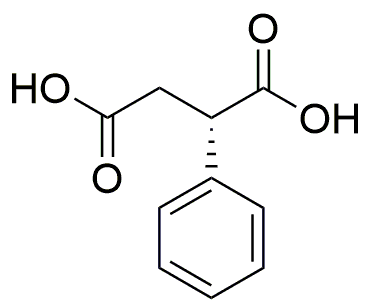(S)-(+)-Phenylsuccinic acid is widely utilized in research focused on:
- Pharmaceutical Development: This compound serves as a chiral building block in the synthesis of various pharmaceuticals, enhancing the efficacy and safety profiles of drugs by enabling the production of enantiomerically pure compounds.
- Polymer Chemistry: It is used in the production of biodegradable polymers, contributing to sustainable materials that reduce environmental impact compared to traditional plastics.
- Food Industry: As a food additive, it can enhance flavor profiles and improve the stability of certain food products, making it a valuable ingredient in food formulation.
- Cosmetics: The compound finds applications in cosmetic formulations, where it acts as a stabilizer and pH adjuster, improving product performance and user experience.
- Research Applications: In academic and industrial research, it is employed as a reagent in organic synthesis, helping scientists develop new compounds and materials with specific properties.
General Information
Properties
Safety and Regulations
Applications
(S)-(+)-Phenylsuccinic acid is widely utilized in research focused on:
- Pharmaceutical Development: This compound serves as a chiral building block in the synthesis of various pharmaceuticals, enhancing the efficacy and safety profiles of drugs by enabling the production of enantiomerically pure compounds.
- Polymer Chemistry: It is used in the production of biodegradable polymers, contributing to sustainable materials that reduce environmental impact compared to traditional plastics.
- Food Industry: As a food additive, it can enhance flavor profiles and improve the stability of certain food products, making it a valuable ingredient in food formulation.
- Cosmetics: The compound finds applications in cosmetic formulations, where it acts as a stabilizer and pH adjuster, improving product performance and user experience.
- Research Applications: In academic and industrial research, it is employed as a reagent in organic synthesis, helping scientists develop new compounds and materials with specific properties.
Documents
Safety Data Sheets (SDS)
The SDS provides comprehensive safety information on handling, storage, and disposal of the product.
Product Specification (PS)
The PS provides a comprehensive breakdown of the product’s properties, including chemical composition, physical state, purity, and storage requirements. It also details acceptable quality ranges and the product's intended applications.
Certificates of Analysis (COA)
Search for Certificates of Analysis (COA) by entering the products Lot Number. Lot and Batch Numbers can be found on a product’s label following the words ‘Lot’ or ‘Batch’.
*Catalog Number
*Lot Number
Certificates Of Origin (COO)
This COO confirms the country where the product was manufactured, and also details the materials and components used in it and whether it is derived from natural, synthetic, or other specific sources. This certificate may be required for customs, trade, and regulatory compliance.
*Catalog Number
*Lot Number
Safety Data Sheets (SDS)
The SDS provides comprehensive safety information on handling, storage, and disposal of the product.
DownloadProduct Specification (PS)
The PS provides a comprehensive breakdown of the product’s properties, including chemical composition, physical state, purity, and storage requirements. It also details acceptable quality ranges and the product's intended applications.
DownloadCertificates of Analysis (COA)
Search for Certificates of Analysis (COA) by entering the products Lot Number. Lot and Batch Numbers can be found on a product’s label following the words ‘Lot’ or ‘Batch’.
*Catalog Number
*Lot Number
Certificates Of Origin (COO)
This COO confirms the country where the product was manufactured, and also details the materials and components used in it and whether it is derived from natural, synthetic, or other specific sources. This certificate may be required for customs, trade, and regulatory compliance.


